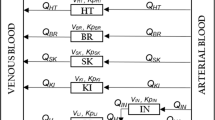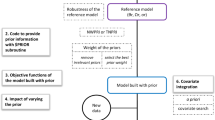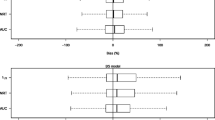Abstract
This paper describes a use of Monte Carlo integration for population pharmacokinetics with multivariate population distribution. In the proposed approach, a multivariate lognormal distribution is assumed for a population distribution of pharmacokinetic (PK) parameters. The maximum likelihood method is employed to estimate the population means, variances, and correlation coefficients of the multivariate lognormal distribution. Instead of a first-order Taylor series approximation to a nonlinear PK model, the proposed approach employs a Monte Carlo integration for the multiple integral in maximizing the log likelihood function. Observations below the lower limit of detection, which are usually included in Phase 1 PK data, are also incorporated into the analysis. Applications are given to a simulated data set and an actual Phase 1 trial to show how the proposed approach works in practice.
Similar content being viewed by others
REFERENCES
J. Steimer, A. Mallet, J. Golmard, and J. Boisvieux. Alternative approaches to estimation of population pharmacokinetic parameters: comparison with the nonlinear mixed-effect model. Drug Metab. Rev. 15:265–292 (1984).
A. Racine-Poon. A Bayesian approach to nonlinear random effects models. Biometrics 41:1015–1023 (1985).
R. Racine, A. P. Grieve, and H. Flühler. Bayesian methods in practice: experiences in the pharmaceutical industry. Appl. Statist. 35:93–150 (1986).
L. B. Sheiner, B. Rosenberg, and V. V. Marathe. Estimation of population characteristics of pharmacokinetic parameters from routine clinical data. J. Pharmacokin. Biopharm. 5:445–479 (1977).
M. J. Lindstrom and D. M. Bates. Nonlinear mixed effects models for repeated measures data. Biometrics 46:673–687 (1990).
E. F. Vonesh and R. L. Carter. Mixed-effects nonlinear regression for unbalanced repeated measures. Biometrics 48:1–17 (1992).
M. Davidian and D. M. Giltinan. Nonlinear Models for Repeated Measurement Data, Chapman & Hall, London, 1995.
A. Yafune and M. Ishiguro. An exact application of maximum likelihood method to pharmacokinetic analysis. Japanese J. Biometrics 13:5–14 (1992).
M. Davidian and A. R. Gallant. Smooth nonparametric maximum likelihood estimation for population pharmacokinetics, with application to quinidine. J. Pharmacokin. Biopharm. 20:529–556 (1992).
M. Davidian and A. R. Gallant. The nonlinear mixed effects model with a smooth random effects density. Biometrika 80:475–488 (1993).
J. C. Pinheiro and D. M. Bates. Approximations to the log-likelihood function in the nonlinear mixed-effects model. J. Comput. Graph. Statist. 4:12–35 (1995).
P. J. Davis and P. Rabinowitz. Methods of Numerical Integration, Academic Press, Boston, 1984.
N. Flournoy and R. K. Tsutakawa (eds.). Statistical Multiple Integration, American Mathematical Society, Providence, 1991.
S. L. Beal and L. B. Sheiner. Heteroscedastic nonlinear regression. Technometrics 30:327–338 (1988).
J. Wakefield and A. Racine-Poon. An application of Bayesian population pharmacokinetic/pharmacodynamic models to dose recommendation. Statist. Med. 14:971–986 (1995).
N. L. Johnson and S. Kotz. Distributions in Statistics, Continuous Univariate Distributions-1, Wiley, New York, 1970, pp. 53–59.
J. W. Mandema, D. Verotta, and L. B. Sheiner. Building population pharmacokinetic-pharmacodynamic models. In D. Z. D'Argenio (ed.), Advanced Methods of Pharmacokinetic and Pharmacodynamic Systems Analysis, Vol. 2, Plenum Press, New York, 1995, pp. 69–86.
L. Devroye. Non-Uniform Random Variate Generation, Springer-Verlag, New York, 1986, pp. 235–236.
W. C. Davidon. Variance algorithm for minimization. Comp. J. 10:406–410 (1968).
M. Ishiguro and H. Akaike. DALL: Davidon's algorithm for log likelihood maximization—a FORTRAN subroutine for statistical model builders. Computer Science Monographs, No. 25, The Institute of Statistical Mathematics, Tokyo (1989).
H. Akaike. Information theory and an extension of the maximum likelihood principle, in B. N. Petrov and F. Csaki (eds.), Second International Symposium on Information Theory, Akademiai Kiado, Budapest, 1973, pp. 267–281. (Reproduced in S. Kotz and N. L. Johnson, eds., Breakthroughs in Statistics, Vol. 1, Springer Verlag, New York, 1992.)
Y. Sakamoto, M. Ishiguro, and G. Kitagawa. Akaike Information Criterion Statistics, Reidel, Dordrecht, 1986.
D. M. Bates and D. G. Watts. Nonlinear Regression Analysis and its Applications, Wiley, New York, 1988, pp. 200–216.
B. Efron. Bootstrap methods: Another look at the jackknife. Ann. Statist. 7:1–26 (1979).
B. Efron and R. J. Tibshirani. An Introduction to the Bootstrap, Chapman & Hall, New York, 1993.
R. J. Carroll and D. Ruppert. Power transformations when fitting theoretical models to data. J. Am. Statist. Assoc. 79:321–328 (1984).
R. J. Carroll and D. Ruppert. Transformation and Weighting in Regression, Chapman & Hall, New York, 1988.
J. W. Mandema, D. Verotta, and L. B. Sheiner. Building population pharmacokinetic-pharmacodynamic models. I. Models for covariate effects. J. Pharmacokin. Biopharm. 20:511–528 (1992).
R. Bruno, N. Vivier, J. C. Vergniol, S. L. D. Phillips, G. Montay, and L. B. Sheiner. A population pharmacokinetic model for docetaxel (Taxotere): Model building and validation. J. Pharmacokin. Biopharm. 24:153–172 (1996).
A. Mallet. A maximum likelihood estimation method for random coefficient regression models. Biometrika 73:645–656 (1986).
A. Mallet, F. Mentré, J. Steimer, and F. Lokiec. Nonparametric maximum likelihood estimation for population pharmacokinetics, with application to cyclosporine. J. Pharmacokin. Biopharm. 16:311–327 (1988).
E. I. Ette and T. M. Ludden. Population pharmacokinetic modeling: The importance of informative graphics. Pharm. Res. 12:1845–1855 (1995).
K. E. Fattinger, L. B. Sheiner, and D. Verotta. A new method to explore the distribution of interindividual random effects in non-linear mixed effects models. Biometrics 51:1236–1251 (1995).
E. I. Ette. Stability and performance of a population pharmacokinetic model. J. Clin. Pharmacol. 37:486–495 (1997).
A. Shapiro. Simulation-based optimization—convergence analysis and statistical inference. Commun. Statist. Stochastic Models 12:425–454 (1996).
Author information
Authors and Affiliations
Rights and permissions
About this article
Cite this article
Yafune, A., Takebe, M. & Ogata, H. A Use of Monte Carlo Integration for Population Pharmacokinetics with Multivariate Population Distribution. J Pharmacokinet Pharmacodyn 26, 103–123 (1998). https://doi.org/10.1023/A:1023280909207
Published:
Issue Date:
DOI: https://doi.org/10.1023/A:1023280909207




